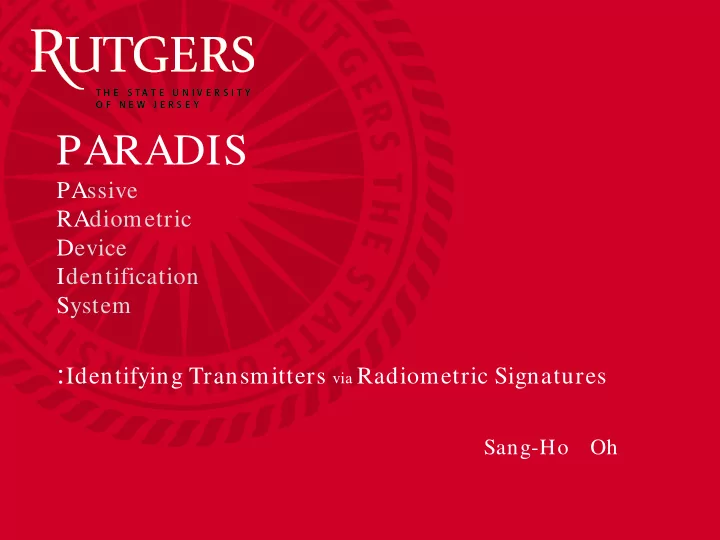

PARADIS PAssive RAdiometric Device Identification System : Identifying Transmitters via Radiometric Signatures Sang-Ho Oh
Radiometric Identification
Waveform Impairments in Analog Frontend • Transmitter – Hardware imperfection – Design architecture • Receiver – Allows certain level of difference for interoperability
Error Signal Vector • Measurement Tool – Vector Signal Analyzer: Agilent VSA 89641S
PARADIS (PAssive RAdiometric Device Identification System) On-line (Identification) phase Training phase Measure the Measure the Identify the Build Error Identify the Build Error Collect RF Collect RF target Signal target Signal Device Device Metric Metric Fingerprints Fingerprints (Bin size = m) (Bin size = m)
Training Phase • Collect fingerprint of each transmitter (20 frames each) • Build a Reference Table based on Error Metrics – User device = {A,B,C,D} – Collect frames per device {a 1 ,a 2 ,a 3 ,… ..a n } – Measure sample vector V = (v 1 ,v 2 ,v 3 ,v 4 ,v 5 )
Classification Algorithms • PARADIS-kNN (k-Nearest-Neighbor) – In training, discard ½ samples (outliers) of user A • Average value of the rest ½ is model M a of user A – For given sample u k , calculate similarity with models for all the users • Fine least value from {| M a -u k | , | M b -u k | , | M c -u k | , | M d -u k | } • PARADIS-SVM (Supported Vector Machines) – Use of LIBSVM • Classification algorithm that builds N-1 dimensional hyper plane in N dimensional space
ORBIT
Performance • Franklin: – Use 802.11 device driver fingerprint – Detect implementation dependent probing algorithm • Hall: – Detect signal transient time in the waveform domain • PARADIS: – Error vector in the Modulation domain
Performance I • False Reject Rate (FRR) – per NIC – System denies authentic users
Performance II • False Accept Rate (FAR) – per NIC – System authenticate wrong user (imposter) – Worst case similarity: Select the most probable imposter
Calibration (Bin: Group of frames) • SVM algorithm need calibration time – But frame by frame identification is possible.
Conclusions • PARADIS – Identifying devices using modulation domain fingerprint is possible with a great precision – Accuracy > 99% – Error < 1% • Key features – Consistency – Unforgeable – Unescapable • Implications – Could be used in intrusion detention systems – Possible privacy compromise
Recommend
More recommend